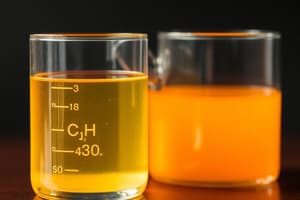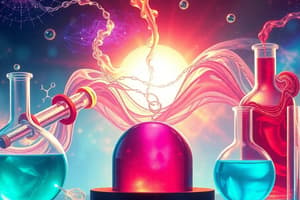Podcast
Questions and Answers
A Lewis base is a species that interacts with a center of positive ______ because of its unshared pair of electrons.
A Lewis base is a species that interacts with a center of positive ______ because of its unshared pair of electrons.
charge
Lewis Bases may be ______ molecules, such as NH3, H2O, R2O, ROH, RSH, H2N-NH2, amines, R3P, R3PO, SF4, etc.
Lewis Bases may be ______ molecules, such as NH3, H2O, R2O, ROH, RSH, H2N-NH2, amines, R3P, R3PO, SF4, etc.
neutral
One class of Lewis acids includes molecules in which an atom does not have an ______ of electrons around it.
One class of Lewis acids includes molecules in which an atom does not have an ______ of electrons around it.
octet
Cations constitute another type of Lewis acid, such as ______+, Fe3+, Ag+, Cr3+, Co3+, Pt2+, VO2+, and BrF2+.
Cations constitute another type of Lewis acid, such as ______+, Fe3+, Ag+, Cr3+, Co3+, Pt2+, VO2+, and BrF2+.
To make predictions of reaction, a very effective method was devised by ______.
To make predictions of reaction, a very effective method was devised by ______.
The hard acids, also known as Class A ______ ions, consist of most of the metal ions in the periodic table.
The hard acids, also known as Class A ______ ions, consist of most of the metal ions in the periodic table.
The hard acids are characterized by low ______ and often high charge densities.
The hard acids are characterized by low ______ and often high charge densities.
Soft acids, with low ______ densities, will be easily polarized; hence, they tend toward covalent bond formation.
Soft acids, with low ______ densities, will be easily polarized; hence, they tend toward covalent bond formation.
The ______ of all acids is gold(I).
The ______ of all acids is gold(I).
The borderline acids are found on the divide between the soft and hard acids and have ______ values as charge densities.
The borderline acids are found on the divide between the soft and hard acids and have ______ values as charge densities.
Flashcards are hidden until you start studying
Study Notes
Solvents and Acid-Base Strength
- Solvent is liquid ammonia, but the Brønsted-Lowry concept can be applied to any solvent.
- The strongest acid that can exist in water is H3O+.
- The strongest base that can exist in water is OH-.
Levelling Effect
- Acids inherently stronger than H3O+ cannot be differentiated by their aqueous ionization.
- This is called the levelling effect.
- Strong acids like nitric acid, sulfuric acid, perchloric acid, and hydrochloric acid cannot be differentiated in water.
Non-Aqueous Solvents and Acid-Base Strength
- The classification of a substance as “weak” or “strong” is stringently tied to the solvent.
- In water, ammonia is a weak base.
Brønsted-Lowry Superacids
- Superacids are molecules with exceedingly weak conjugate bases, resulting in acids that can potentially transfer protons to species that could not be appreciably protonated by leveled acids.
- George Olah proposed using superacids to protonate monocationic species to produce useful concentrations of dicationic ions with increased reactivity.
- The stronger the acid, the more negative H0 is.
- All proton-producing acids stronger than 100% sulfuric acid are considered superacids.
Magic Acid
- Magic acid is a term coined for a mixture of antimony pentafluoride and fluorosulfonic acid that can protonate hydrocarbons.
Brønsted-Lowry Strength of Oxyacids
- The acid strength of oxyacids (oxoacids) of chlorine in aqueous solution ranks as follows: HClO4 > HClO3 > HClO2 > HClO.
- The pKa values increase by about five units with each successive proton removal.
- The trends in these pKa values are rationalized on the basis of electronegativity and resonance arguments.
- Oxygen atoms have a high electronegativity and influence the distribution of electron density in molecules.
- The net result is that the electron density supporting the O–H bond decreases as the number of oxygen atoms increases.
- This renders the O–H bond more susceptible to heterolytic cleavage associated with Brønsted-Lowry proton transfer.
Trends Within a Series of Oxyacids
- As the number of oxygen atoms increases, oxyacid acid strength increases.
- Bell’s Rule relates the first acid dissociation constant to the number of ‘hydrogen-free’ O atoms in an acid: pKa ≈ 8 − 5n.
Solvent System Concept
- Applies to any solvent that can dissociate into an anion and a cation (auto-dissociate).
- The cation from the dissociation is the acid.
- The anion from the dissociation is the base.
- Solutes that increase the concentration of the cation are considered acids.
- Solutes that increase the concentration of the anion are considered bases.
The Lux-Flood Theory (Acid and Base)
- The Lux-Flood theory is a special theory that is devoted to solventless acid-base reactions, such as those of oxides.
- A Lewis base is a species that interacts with a center of positive charge (or deficiency of electrons) because of its unshared pair of electrons.
- A Lewis base is known as a nucleophile.
Lewis Concept (Acid and Base)
- Lewis bases may be neutral molecules or anions.
- One class of Lewis acids includes molecules in which an atom does not have an octet of electrons around it.
- Cations constitute another type of Lewis acid.
Hard – Soft Acid – Base Concept
- Thermodynamics can be used to predict the feasibility of chemical reactions, but complete thermodynamic data is not always available.
- Pearson proposed that Lewis acids and bases could be classified as “hard” or “soft” to make predictions.
- Hard acids are characterized by low electronegativities and often high charge densities.
- Soft acids have low charge densities and tend toward covalent bond formation.
- The softest of all acids is gold(I).
- Borderline acids have intermediate values as charge densities, and oxidation state becomes a crucial factor in determining hardness.
Studying That Suits You
Use AI to generate personalized quizzes and flashcards to suit your learning preferences.




